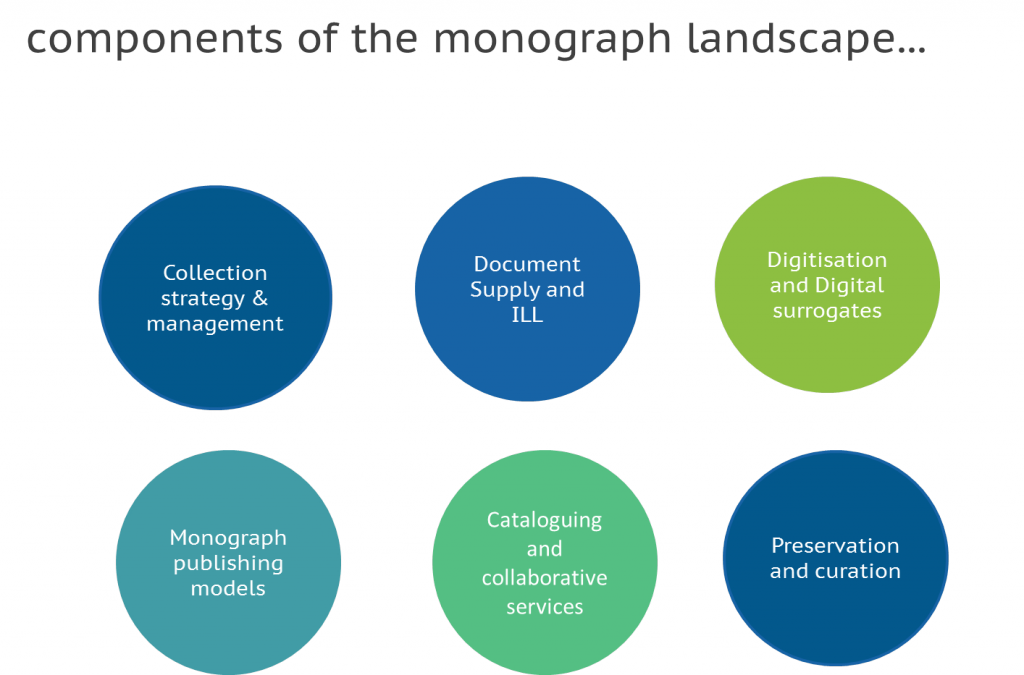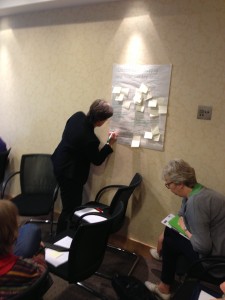The National Monographs Strategy project saw the light of day for the first time recently at the SCONUL conference in Dublin.
This was an opportunity to talk a little bit about the project and our approach, and more importantly, a chance to get some initial feedback and input into the project from around 20 senior library managers and directors.
The workshop was fairly intensive – we worked the participants hard. But the results were very rich, and have already been incorporated into the landscape work the project is currently undertaking (more on that shortly!).
The session started with a very brief overview of the project and outlined some of the main components of the current monographs landscape that the project has begun to map.
After providing an overview of the project and landscape the room was divided up into 4 sections, with people assigned a particular challenge ares (these were: Document supply and ILL, Collection strategy and management, Preservation and curation and, Monograph publishing models). We then asked participants to:
- Work individually to note down as many drivers for change in their specific challenge area;
- After about 5 mins, delegates came together to compare drivers for their area. These were then rationalised, de-duplicated and where necessary, deaccessioned!
- Each group was asked to prioritise their top three drivers, and any next steps/opportunities that are relevant to that area (if there was time).
- Each group reported back their top 3 drivers.
Document Supply and Inter-library lending
Three top priority drivers for change:
Fast supply to users (user experience): Google instant results/expectation of instantaneous content; Print on demand; Just-in-Time library model; Less need for ILL; User experience; open access.
Reduced budgets (financial): Demonstrating value for money (and need for shared services); cost/economics of monographs; reducing acquisitions budgets.
Repurposing space (space and demonstrating VfM): Repurposing space for students/researchers; Study, not storage; Rental costs Vs. Storage costs; consortial approach to de-duplication/storage/study space.
Some possible next steps:
- Need to engage with national libraries (including Scottish and Irish) and other large, trusted, suppliers;
- Focus on digital delivery (ebooks);
- Engage Google, microsoft, Netflix, Apple etc (we can’t do this by ourselves!?);
- Explore international exemplars (Australia, N. America etc);
- Use existing tools (CCM etc);
- Shared activity around space (i.e., storage, and UKRR);
- Role of KB+ (specifically around ebooks).
Collection Strategy and Management
Three top priority drivers for change:
Space (repurposing use of space): Managing legacy collections; shared storage and retrieval; rightsizing collections.
Changing publishing models (from ownership to rental): Slice and dice model for high demand materials; PDA; rental models; MOOCs, online learning; preservation/protection.
Cost and Value (Making the most of limited resources).
Some possible next steps:
- Focus on quick wins. Longer term = changing mindsets.
- Importance of PDA and scanning of course readings/materials (and ILL);
- Institutional strategy i.e., strategic move to delivery via VLE for course materials;
- Reciprocal arrangements (walk-in access etc)
Preservation and Curation
Three top priority drivers for change:
Sharing/saving costs (shared savings of a national approach): Sharing costs of digital preservation; efficiency of national collection; saving staff time; de-duplication of local effort; national e-monograph approach; non-print legal deposit.
Improving access (access to unique collections): improving access to non-HE/national collections; access to unique collections.
Quantifying costs (understanding the cost Vs value equation): quantify cost of digital curation; monograph as a format may not be efficient/represent value.
Next steps:
- Build on existing search/access platforms such as Search25, Copac;
- Develop a consortia framework (and social capital ?)
- Development of metadata frameworks and standards.
- Explore UKRR and possible data on financial benefit of de-duplication of curation/preservation.
Underpinning this whole area was the need for a legal/deposit framework (to cover areas such as the deterioration of physical collections etc).
Monograph Publishing Models
Three top priority drivers for change:
Technology (transformative impact of digital technologies): Changes in technology and consumption of content; pressure for digital/digitised texts; accessibility and usability of e-readers.
Cost (the new economics of publishing): Open Access; Ownership Vs. Renting; costs associated with renting; re-use/double-dipping of content (repackaging content); bundles Vs. single items; costs of production; success of ‘big deals’ in e-journals and the economies of scale; economics of the long-tail.
Container (the format of the monograph): Open Access; self-publishing; textbooks; changing academic practice; fractured publishing; REF and research assessments.
There were no clear next steps from this group. This was partly a symptom of this being a more challenging area generally, and also the relative immaturity of this area of the landscape. It is an emergent component with serious wider implications.
Finally, a couple of pictures of librarians hard at work during the session!





Wow, that’s difficult to say. I like stories, love books
– the way the pages feel under my fingers.